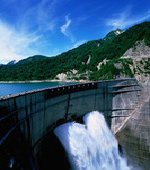 Drain on the Mediterranean: rising water usage
Drain on the Mediterranean: rising water usage
In a dramatic illustration of a broader regional crisis, a Turkish lake
three times the size of Washington, D.C., has dried up in the past 15 years.
Dubbed the country's grain warehouse, central Turkey's Konya plain has long
been known for its beautiful lakes and vast fields, which produce 10 percent
of Turkey's agricultural yield. But both are now threatened by a severe
water shortage that dramatically illustrates a broader regional
crisis.
Across the Mediterranean, water is being pumped out of the earth at an
unsustainable pace. In Italy's Milan region, groundwater levels have fallen
by more than 80 feet over the past 80 years. So much water has been pumped
from the Jeffara aquifer in Libya that even if all withdrawals stopped, it
would take 75 years for the aquifer to return to its original level,
estimates a 2005 report by the Blue Plan – a United Nations program on
development and the environment in the Mediterranean.
As a result of this profligate water use, at least 50 percent of the
region's wetlands are at risk, according to the World Wildlife Fund (WWF).
In addition, more than 100,000 square miles of coastal regions – roughly the
same area as the United Kingdom – are under threat of desertification.
Near Konya, water pumped from underground to feed the thirsty crops above is
part of the same closed system as the lakes. The cultivation of new land,
along with a transition to more thirsty crops like sugar beet, has increased
water use beyond what is naturally replaced, causing groundwater levels to
fall and the lakes to dry up. More than a decade of drought and rising
summer temperatures – which causes increased evaporation – have exacerbated
the situation and laid bare the magnitude of the problem.
The Turkish government has a plan to divert water from the Goksu River to
the Konya Basin for agricultural use and to fill the depleted lakes and
wetlands. To date, the focus of most countries confronting water shortages
has been to increase supply, often through massive infrastructure projects
like dams, says Gael Thivet of the Blue Plan. More emphasis, experts say,
needs to be placed on saving or reusing water, as well as on reducing
demand.
Freshwater has always been a scarce commodity in the semi-arid
Mediterranean. It has 7 percent of the world's population, but only 3
percent of its freshwater resources. And the UN-sponsored Intergovernmental
Panel on Climate Change (IPCC) report predicts that global warming may lead
to less rainfall and more evaporation in the region, further reducing the
supply of water.
Half the world's "water poor" – that is, people whose access to freshwater
is deemed inadequate – live in the Mediterranean region, mostly on the sea's
eastern and southern shores. By 2025, the Blue Plan predicts that due to
population growth and expanding agriculture, the number of water poor in the
region could be as high as 165 million in 2025, up from 108 million in
2000.
But human demand for this vital resource is booming. During the second half
of the 20th century, water usage in the Mediterranean doubled. While a
handful of countries, like Israel and Cyprus, have reduced or stabilized
their water use, in most countries the demand for water is expected to
continue to rise in coming decades.
In general, the countries with the fastest-growing water demands are those
on the Mediterranean's southern and eastern shores, where the population is
set to increase by 92 million in less than two decades. Irrigation is also
set to expand dramatically by 2030, rising 38 percent in the south and 58
percent to the east.
In Konya, as elsewhere in the Mediterranean, agriculture is the biggest user
of water. Around the city, vast fields of wheat, barley, corn, and beets are
grown, much of it irrigated with groundwater from the same hydrologic system
used by the disappearing lakes. An estimated 70 percent of the water
consumption in the area is used for agriculture, much of it drawn from
illegally drilled wells, says Dr. Gocmez.
| Contact information | n/a |
|---|---|
| News type | Inbrief |
| File link |
http://www.csmonitor.com/2008/0115/p01s04-woeu.html |
| Source of information | CS Monitor |
| Keyword(s) | groundwater, drought, UNEP-MAP, desertification, wetlands, climate change, irrigation |
| Subject(s) | AGRICULTURE , NATURAL MEDIUM , POLICY-WATER POLICY AND WATER MANAGEMENT , RISKS AND CLIMATOLOGY , WATER DEMAND |
| Relation | http://www.emwis.net/topics/WaterScarcity |
| Geographical coverage | Turkey, Italy, Israel, Cyprus |
| News date | 18/01/2008 |
| Working language(s) | ENGLISH |
 you are not logged in
you are not logged in





